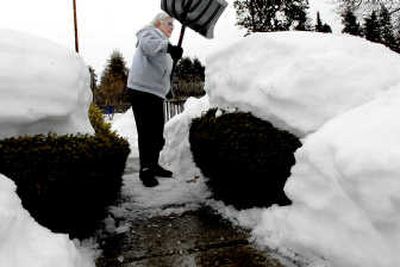Melting back to normal, sort of

For two weeks they were snowbound.
And even when they returned to schools in the Reardan-Edwall district west of Spokane on Monday, it was two hours later than normal.
That late start was the school district’s latest concession to the deep and drifting snow that has closed roads, stranded truckers and caused roofs to collapse throughout the Inland Northwest.
The melting that began in earnest over the weekend will continue this week. But with daytime temperatures expected in the low 40s and overnight lows below freezing, it will be a gradual melt, said Jonathan Fox, a meteorologist with the National Weather Service in Spokane.
“Really, the flooding threat is pretty minimal,” Fox said.
Hangman Creek in Spokane County was flowing lower than average Monday, according to the U.S. Geological Survey. Monday’s peak flow on the Palouse River was slightly higher than average but nowhere near flood stage. Both rivers are rapidly affected by runoff.
Morning commuters may encounter icy roads, Fox said. But the high winds that caused treacherous road conditions last week in southern and western Spokane County aren’t expected to return.
County officials closed dozens of rural roads Friday because of deep snowdrifts and declared a state of emergency. Most roads reopened at least partially Saturday, and officials hoped to have all roads on the west side of the county open to at least one lane by today. Crews hoped to reopen roads in the southeast corner of the county to at least one lane by Thursday.
To the west, Stevens Pass and eastbound Interstate 90 at Snoqualmie Pass were closed for part of the day Monday because of slides, according to the Washington Department of Transportation. U.S. Highway 12 in Idaho remains closed from the Selway River Road to Lolo Pass because of avalanches.
While most schools in Spokane and Spokane Valley were closed up to four days the last week of January, rural districts have been hardest hit.
“The first week it was because of snow,” said Doug Asbjornsen, superintendent of the Reardan-Edwall School District.
Then, last Thursday, the wind kicked up and created snowdrifts. About 45 miles of U.S. Highway 2 was closed, and Asbjornsen, like some of his students and staff, was trapped at home.
When he was finally able to get out of his home north of Fairchild Air Force Base, Asbjornsen found 10-foot walls of white lining Highway 2 where plows had worked to move the drifts.
Asbjornsen said his district plans to ask for a waiver from the state for the days missed. School districts in areas where Gov. Chris Gregoire declared an emergency can ask to have missed days forgiven.